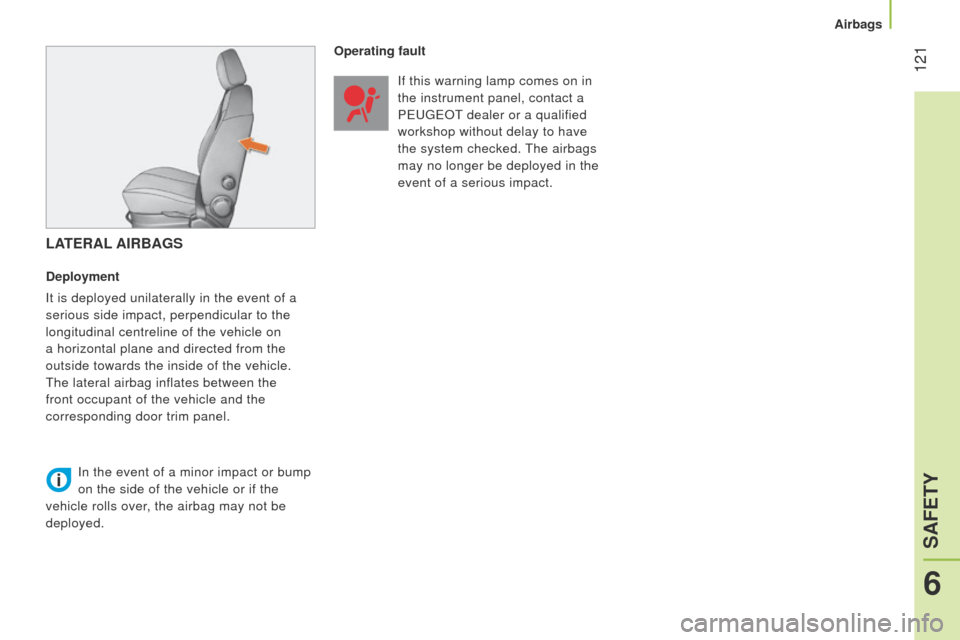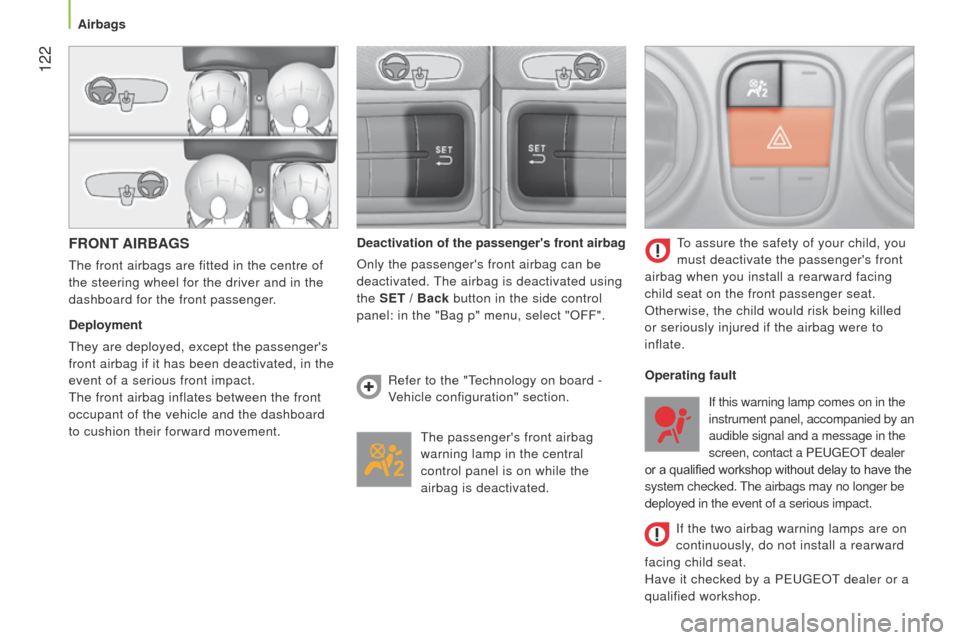2015 Peugeot Bipper instrument panel
[x] Cancel search: instrument panelPage 123 of 192

121
Bipper_en_Chap06_securite_ed02-2014
LATERAL AIRBAGS
Deployment
It is deployed unilaterally in the event of a
serious side impact, perpendicular to the
longitudinal centreline of the vehicle on
a horizontal plane and directed from the
outside towards the inside of the vehicle.
t
he lateral airbag inflates between the
front occupant of the vehicle and the
corresponding door trim panel.
In the event of a minor impact or bump
on the side of the vehicle or if the
vehicle rolls over, the airbag may not be
deployed. Operating fault
If this warning lamp comes on in
the instrument panel, contact a
P euge O t
dealer or a qualified
workshop without delay to have
the system checked.
t
he airbags
may no longer be deployed in the
event of a serious impact.
6
SAFETY
Airbags
Page 124 of 192

122
Bipper_en_Chap06_securite_ed02-2014
FRONT AIRBAGS
the front airbags are fitted in the centre of
the steering wheel for the driver and in the
dashboard for the front passenger.
Deployment
t
hey are deployed, except the passenger's
front airbag if it has been deactivated, in the
event of a serious front impact.
t
he front airbag inflates between the front
occupant of the vehicle and the dashboard
to cushion their forward movement. Deactivation of the passenger's front airbag
Only the passenger's front airbag can be
deactivated. t
he airbag is deactivated using
the SET / Back button in the side control
panel: in the "Bag p" menu, select "OFF".
t
he passenger's front airbag
warning lamp in the central
control panel is on while the
airbag is deactivated.
to assure the safety of your child, you
must deactivate the passenger's front
airbag when you install a rearward facing
child seat on the front passenger seat.
Otherwise, the child would risk being killed
or seriously injured if the airbag were to
inflate.
Refer to the "
t
echnology on board -
Vehicle configuration" section. Operating fault
If the two airbag warning lamps are on
continuously, do not install a rearward
facing child seat.
Have it checked by a P
euge O t
dealer or a
qualified workshop. If this warning lamp comes on in the
instrument panel, accompanied by an
audible signal and a message in the
screen, contact a P
euge O t
dealer
or a qualified workshop without delay to have the
system checked.
t
he airbags may no longer be
deployed in the event of a serious impact.
Airbags
Page 144 of 192

142
Bipper_en_Chap08_verifications_ed02-2014
FILLING WITH FUEL
Capacity of the fuel tank: approximately 45 litres.
Low fuel level
When the minimum fuel tank level
is reached, this warning lamp
comes on. When it first comes on,
you have approximately 6 litres
of fuel remaining. Refuel without delay to
avoid running out of fuel.
An arrow in the instrument panel indicates
which side of the vehicle the filler flap is
located.
Refuelling must be done with the engine off.
-
Open the fuel filler flap.
-
Hold the filler cap with one hand.
-
With the other hand, insert the key
, then
turn it a third of a turn.
-
Remove the filler cap and hang it on the
hook, located on the inside of the filler
flap.
FUEL CUT-OFF
In the event of a serious collision, a device
automatically cuts off the fuel supply to the
engine and the vehicle's electrical supply.
It also automatically unlocks the doors
and switches on of the courtesy lamps. A
message appears in the instrument panel
screen according to version.
turn the key to the
STOP position to prevent
discharging of the battery.
Check that there is no smell or leak of fuel
outside the vehicle.
With Stop & Start, never refuel with the
system in S
t
OP
mode; you must switch
off the ignition with the key. When the fuel filler flap is open, a
safety system prevents sliding of the
side door (Combi).
A label affixed to the inside of the flap
reminds you of the type of fuel to be used.
Opening the filler cap may cause a noise
resulting from the inrush of air.
t
his vacuum
is quite normal and results from the sealing
of the fuel system.
When filling the fuel tank, do not continue
after the 3rd cut-off of the nozzle; this could
cause malfunctions.
After filling the fuel tank, lock the filler cap
and close the flap.
Fuel
Page 149 of 192

147
Bipper_en_Chap08_verifications_ed02-2014
these regular maintenance operations will
keep your vehicle in good working order .
Ask for advice from a P
euge O t
dealer or a
qualified workshop or refer to the warranty
and maintenance record provided in the
handbook pack.
LEVELS
Oil level
Check the level regularly and top up
between changes.
t
he maximum oil
consumption is 0.5 litre per 600 miles
(1 000
km). Check the level with the vehicle
level, engine cold, using the dipstick.
Dipstick
t
here are two marks on the
dipstick:
A = maximum
If you fill past this mark,
contact a P
euge O t
dealer
or a qualified workshop.
B = minimum
Never allow the level to fall
below this mark.
to preserve the reliability of engines and
emission control systems, the use of
additives in engine oil is prohibited. Oil change
Brake fluid level
the brake fluid must be changed at
the specified interval, as given in the
manufacturer's servicing schedule.
u
se fluids recommended by the
manufacturer, which meets the DO
t 4
standard.
t
he level must be between the MIN and
MAX marks on the reservoir.
If fluid has to be added frequently, this
indicates a fault which must be checked by a
P
euge O t
dealer or a qualified workshop as
soon as possible.
Warning lamps
Checking by means of the warning
lamps in the instrument panel is
described in the "Ready to set off -
Instruments and controls" section.
t
his must be carried out at the specified
interval and the viscosity grade of the oil
selected must fulfil the requirements of the
manufacturer's servicing schedule. Ask
for advice from a P
euge
O
t
dealer or a
qualified workshop.
Remove the dipstick before filling.
Check the level after filling (never exceed
the maximum mark).
Refit the filler cap before closing the bonnet.
8
CHECKS
Levels
Page 153 of 192

151
Bipper_en_Chap08_verifications_ed02-2014
Particle filter (1.3 HDi 75)
An addition to the catalytic converter, this
filter makes an active contribution to the
preservation of air quality by the retaining
of the unburnt pollutant particles. Black
exhaust fumes are thus no longer emitted.
t
his filter, fitted to the exhaust system,
accumulates particles of soot.
t
he engine
control unit manages the automatic
periodic elimination of the soot particles
(regeneration).
the regeneration procedure is invoked
according to the quantity of particles
accumulated and the driving conditions
of the vehicle. During this phase, you
may notice some unusual phenomena -
increased idling speed, cooling fan running,
increase in smoke and higher exhaust gas
temperature
- which does not affect the
operation of the vehicle or the environment.
After prolonged idling or driving at very low
speeds, you may occasionally notice water
vapour being emitted from the exhaust when
accelerating.
t
his is of no consequence
to the running of the vehicle or to the
environment. Saturation / Regeneration
If there is risk of blockage of the
filter, this warning lamp comes on
in the instrument panel.
t
his alert tells you that the
particle filter is starting to fill up (in
conditions of urban driving of exceptionally
long duration: low speeds, traffic jams etc.)
to regenerate the filter
, it is advised to drive
as soon as possible, when traffic conditions
and the law permit, at a speed of at least
40 mph (around 60 km/h), with an engine
speed above 2 000 rpm for about fifteen
minutes (until the warning lamp and/or the
message disappears). Operating fault
If this alert persists, do not ignore the
warning; it indicates that a fault has occurred
in the exhaust / particle filter system.
Have it checked by a P
euge O t
dealer or a
qualified workshop.
Because of the higher exhaust
gas temperature resulting from the
normal operation of the particle filter, it is
recommended that you do not park the
vehicle over inflammable materials (grass,
dry leaves, pine needles,
...) so as to avoid
any risk of fire. If possible, avoid switching off the
engine before the end of regeneration
of the filter, repeated interruptions could
cause premature deterioration of the
engine oil. It is not recommended to end
regeneration of the filter with the vehicle
stationary.
8
CHECKS
Checks
Page 170 of 192

168
Bipper_en_Chap09_aide-rapide_ed02-2014
Table of dashboard fuses, driver’s
sideMarking RatingFunctions
F12 7.5 ARight-hand dipped beam headlamp supply
F13 7.5 A
l
eft-hand dipped beam headlamp supply - headlamp height
adjuster
F31 5 A
e
ngine control unit supply switch
F32 7.5 AFront lamp - front courtesy lamp - rear courtesy light lamp
F36 10 AAudio system - mobile telephone pre-equipment -
air conditioning control panel -
e ODB diagnostic socket
F37 5 ABrake lamp - instrument panel
F38 20 ADoor locking
F43 15 AScreenwash pump
F47 20 ADriver’s electric window motor supply
F48 20 APassenger’s electric window motor supply
F49 5 AParking sensors control unit - rear lighting switch -
electric door mirrors - volumetric alarm
control unit
F50 7.5 AAirbags control unit
F51 7.5 ASwitch on brake pedal - switch on clutch pedal -
door mirror controls - central Bluetooth
system
F53 5 AInstrument panel - rear foglamps
Changing a fuse